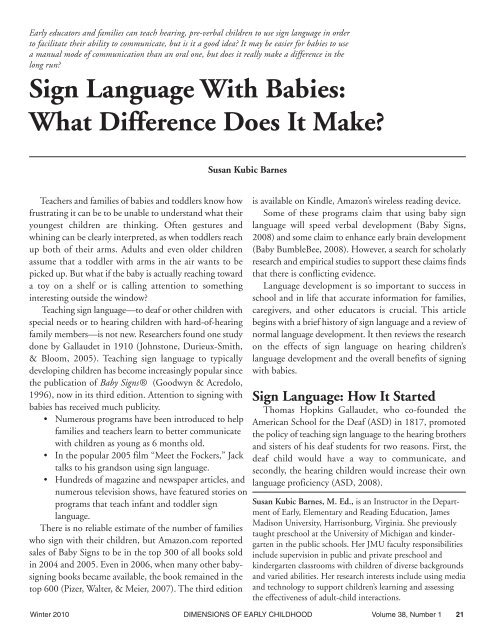90223 Dimensions Winter 10:Layout 1 - Southern Early Childhood ...
90223 Dimensions Winter 10:Layout 1 - Southern Early Childhood ...
90223 Dimensions Winter 10:Layout 1 - Southern Early Childhood ...
Create successful ePaper yourself
Turn your PDF publications into a flip-book with our unique Google optimized e-Paper software.
<strong>Early</strong> educators and families can teach hearing, pre-verbal children to use sign language in order<br />
to facilitate their ability to communicate, but is it a good idea? It may be easier for babies to use<br />
a manual mode of communication than an oral one, but does it really make a difference in the<br />
long run?<br />
Sign Language With Babies:<br />
What Difference Does It Make?<br />
Susan Kubic Barnes<br />
Teachers and families of babies and toddlers know how<br />
frustrating it can be to be unable to understand what their<br />
youngest children are thinking. Often gestures and<br />
whining can be clearly interpreted, as when toddlers reach<br />
up both of their arms. Adults and even older children<br />
assume that a toddler with arms in the air wants to be<br />
picked up. But what if the baby is actually reaching toward<br />
a toy on a shelf or is calling attention to something<br />
interesting outside the window?<br />
Teaching sign language—to deaf or other children with<br />
special needs or to hearing children with hard-of-hearing<br />
family members—is not new. Researchers found one study<br />
done by Gallaudet in 19<strong>10</strong> (Johnstone, Durieux-Smith,<br />
& Bloom, 2005). Teaching sign language to typically<br />
developing children has become increasingly popular since<br />
the publication of Baby Signs® (Goodwyn & Acredolo,<br />
1996), now in its third edition. Attention to signing with<br />
babies has received much publicity.<br />
• Numerous programs have been introduced to help<br />
families and teachers learn to better communicate<br />
with children as young as 6 months old.<br />
• In the popular 2005 film “Meet the Fockers,” Jack<br />
talks to his grandson using sign language.<br />
• Hundreds of magazine and newspaper articles, and<br />
numerous television shows, have featured stories on<br />
programs that teach infant and toddler sign<br />
language.<br />
There is no reliable estimate of the number of families<br />
who sign with their children, but Amazon.com reported<br />
sales of Baby Signs to be in the top 300 of all books sold<br />
in 2004 and 2005. Even in 2006, when many other babysigning<br />
books became available, the book remained in the<br />
top 600 (Pizer, Walter, & Meier, 2007). The third edition<br />
is available on Kindle, Amazon’s wireless reading device.<br />
Some of these programs claim that using baby sign<br />
language will speed verbal development (Baby Signs,<br />
2008) and some claim to enhance early brain development<br />
(Baby BumbleBee, 2008). However, a search for scholarly<br />
research and empirical studies to support these claims finds<br />
that there is conflicting evidence.<br />
Language development is so important to success in<br />
school and in life that accurate information for families,<br />
caregivers, and other educators is crucial. This article<br />
begins with a brief history of sign language and a review of<br />
normal language development. It then reviews the research<br />
on the effects of sign language on hearing children’s<br />
language development and the overall benefits of signing<br />
with babies.<br />
Sign Language: How It Started<br />
Thomas Hopkins Gallaudet, who co-founded the<br />
American School for the Deaf (ASD) in 1817, promoted<br />
the policy of teaching sign language to the hearing brothers<br />
and sisters of his deaf students for two reasons. First, the<br />
deaf child would have a way to communicate, and<br />
secondly, the hearing children would increase their own<br />
language proficiency (ASD, 2008).<br />
Susan Kubic Barnes, M. Ed., is an Instructor in the Department<br />
of <strong>Early</strong>, Elementary and Reading Education, James<br />
Madison University, Harrisonburg, Virginia. She previously<br />
taught preschool at the University of Michigan and kindergarten<br />
in the public schools. Her JMU faculty responsibilities<br />
include supervision in public and private preschool and<br />
kindergarten classrooms with children of diverse backgrounds<br />
and varied abilities. Her research interests include using media<br />
and technology to support children’s learning and assessing<br />
the effectiveness of adult-child interactions.<br />
<strong>Winter</strong> 20<strong>10</strong> DIMENSIONS OF EARLY CHILDHOOD Volume 38, Number 1 21
















